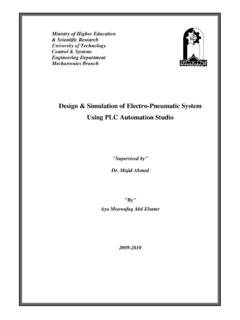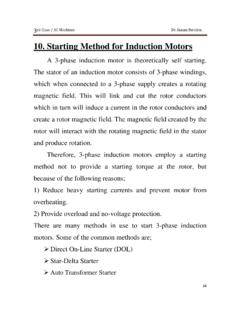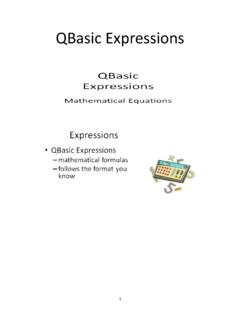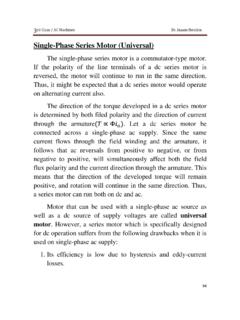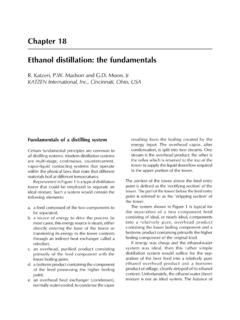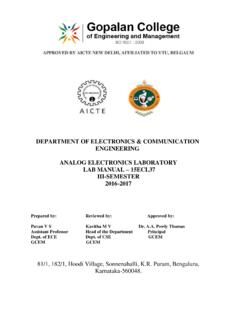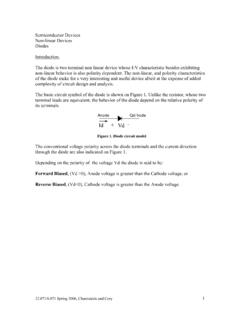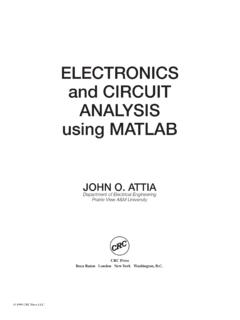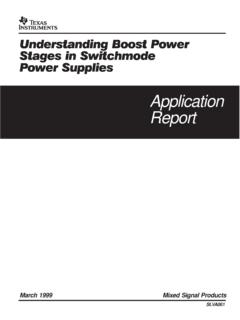Transcription of 11. Diode Equivalence Circuits
1 Fundamentals of Electronic circuit design First Class Lecture 7: 11. Diode Equivalence Circuits : An equivalent circuit is a combination of elements properly chosen to best represent the actual terminal characteristics of a device, system, or such in a particular operating pregion. In other words, once the equivalent circuit is defined, the device symbol can be removed from a schematic and the equivalent circuit inserted in its place without severely affecting the actual behavior of the system. The result is often a network that can be solved using traditional circuit analysis techniques. Fundamentals of Electronic circuit design First Class Diode applications: LOAD-LINE ANALYSIS: The applied load will normally have an important impact on the point or region of operation of a device.
2 If the analysis is performed in a graphical manner, a line can be drawn on the characteristics of the device that represents the applied load. The intersection of the load line with the characteristics will determine the point of operation of the system. Such an analysis is, for obvious reasons, called load-line analysis. (a) (b). Fig (2-1) Diode series configuration (a): circuit (b): characteristic Applying Kirchhoff s voltage law to the series circuit of Fig. will result in Or ..eq ( ). If we set VD =0 V in Eq. ( ) and solve for ID, we have the magnitude of ID on The vertical axis. Therefore, with VD =0 V, Eq. ( ) becomes: Fundamentals of Electronic circuit design First Class And Fig (2-2).
3 As shown in Fig. If we set ID =0 A in Eq. ( ) and solve for VD, we have the Magnitude of VD on the horizontal axis. Therefore, with ID =0 A, Eq. ( ) becomes And Example( ): Fundamentals of Electronic circuit design First Class For the series Diode configuration of Fig. employing the Diode characteristics of Fig. determine: (a) VDQ and IDQ. (b) VR. Diode APPROXIMATIONS. Fundamentals of Electronic circuit design First Class Lecture 8: Series Diode configurations with DC inputs In general, a Diode is in the on state if the current established by the applied sources is such that its direction matches that of the arrow in the Diode symbol, and VD . for silicon and VD for germanium.
4 Fundamentals of Electronic circuit design First Class (a)Series Diode configuration (b) Determining the state of Diode of fig (a). (C) Substituting the equivalent model of on Diode of fig (a). FIG ( a, b, c). Fundamentals of Electronic circuit design First Class (a) Reversing Diode of Diode in fig( a) (b) determining the state of Diode in fig( a). (c) Substituting the equivalent model of off Diode of fig ( ). Fig ( a, b, c). The Diode is in the off state, resulting in the equivalent circuit of Fig. Due to the open circuit , the Diode current is 0 A and the voltage across the resistor R is the following: Example : for series Diode configurations of fig ( ), determine and ID.
5 FIG ( ). Fundamentals of Electronic circuit design First Class Example 3: for series Diode configuration of fig ( ), determine VD, VR and ID. Solution: And Fig ( ). Example: determine , V for circuit of fig ( ). Solution: Fundamentals of Electronic circuit design First Class (a) Determine the state of diodes of circuit in the example (b) Subsisting the equivalent state for the open Diode (c) Determine unknown quantities for circuit of example Fundamentals of Electronic circuit design First Class Example 4: Determine I, V1, V2 and VO for the circuit of fig Solution: Fundamentals of Electronic circuit design First Class Parallel and series-parallel configurations: Example 5: Determine I 1, ID1, ID2 and VO for the circuit of fig: Fundamentals of Electronic circuit design First Class Solution: Example 6: Determine the current I for the network of fig Solution.
6 Fundamentals of Electronic circuit design First Class One of the very import applications of Diode switching Circuits is Diode logic Circuits AND/OR Gates. OR gate: is such that the output voltage level will be a 1 if either or both input is a 1. The 10V level is assigned a 1 for Boolean algebra while the 0V input is assigned a 0. Fundamentals of Electronic circuit design First Class Example 1: Determine Vo for the network in fig: D1 is in the on state due to the applied voltage (10V) while D2 is in the off state . Vo = E - VD = 10v - = = (E - VD ) / R = ( ) / 1K = The output voltage level is not 10V as defined for an input of 1, but the is sufficiently at a 1 level with only one input.
7 Fundamentals of Electronic circuit design First Class AND gate: is such that the output voltage level is will be 1 if both inputs are a 1. Example 2: Determine the output level for the positive logic AND gate of fig: With 10v at the cathode D1 , is assumed that D1 is in the off state. D2 is assumed to be in the on state due to the low voltage at the cathode side and the Availability of the 10v source through 1K resistor. The voltage at Vo is due to forward biased Diode D2 I = (E-Vo) / R = ( ) / 1K = Fundamentals of Electronic circuit design First Class Lecture 10: 3. Half-Wave rectifier : Half-wave rectification: is the process of removing one half of the input signal to establish a dc level.
8 The cct of the fig( ) called a half wave rectifiers will generates a waveform Vo that will have an average value of particular use in the ac to dc conversion process. Fig( ) half wave rectifier During the interval (t=0 to T/2) the polarity of the input voltage Vi is shown in fig( ). Fig( )conducting region(0 to T/2). The result that for period 0 to T/2, Vo=Vi. For period T/2 to T, the polarity of the input voltage Vi is shown in fig( ) and the ideal Diode produces in off state, Vo=0V. Fundamentals of Electronic circuit design First Class Fig( ) Non conducting region (T/2 to T). An average value determined by average value determined by average dc value =. FIG( ) Half-Waves rectified signal The effect of using a silicon Diode with VT= is shown by fig (2-20) for the forward bias.
9 The input must now be at least before the Diode conducts. When conducting Vo =Vi - VT. If Vm > VT Vdc= if Vm is close to VT Vdc (Vm VT). Fundamentals of Electronic circuit design First Class fig( ) Effect of VT on half-wave rectified signal Example 1: for Half wave rectifier : (a) Sketch the output vo and determine the dc level of the output for the network of Fig ( ). (b) Repeat part (a) if the ideal Diode is replaced by a silicon Diode . Fig( ). Solution: (a) In this situation the Diode will conduct during the negative part of the input and vo will appear as shown in fig ( ). Fundamentals of Electronic circuit design First Class For full period, the DC level is: Vdc = = (20) = V.
10 (b) Using a silicon Diode , the output has the appearance of Fig ( ). Rectification The dc level obtained from a sinusoidal input by half wave rectifier can be improved using a process called Full-Wave Rectification. Four diodes in a bridge configuration can be used as Full Wave rectifier as shown in fig ( ). Fig ( ) full wave bridge rectifier fig ( ) network for period (0 to T/2). For the positive region of the input the conducting diodes are D2 & D3 while D1& D4 are in the off state as shown in fig ( ). Fig ( ). For the negative region of the input the conducting diodes are D1 & D4 while D2 & D3 are in the off state as shown in fig ( ). Fundamentals of Electronic circuit design First Class Fig( ).


